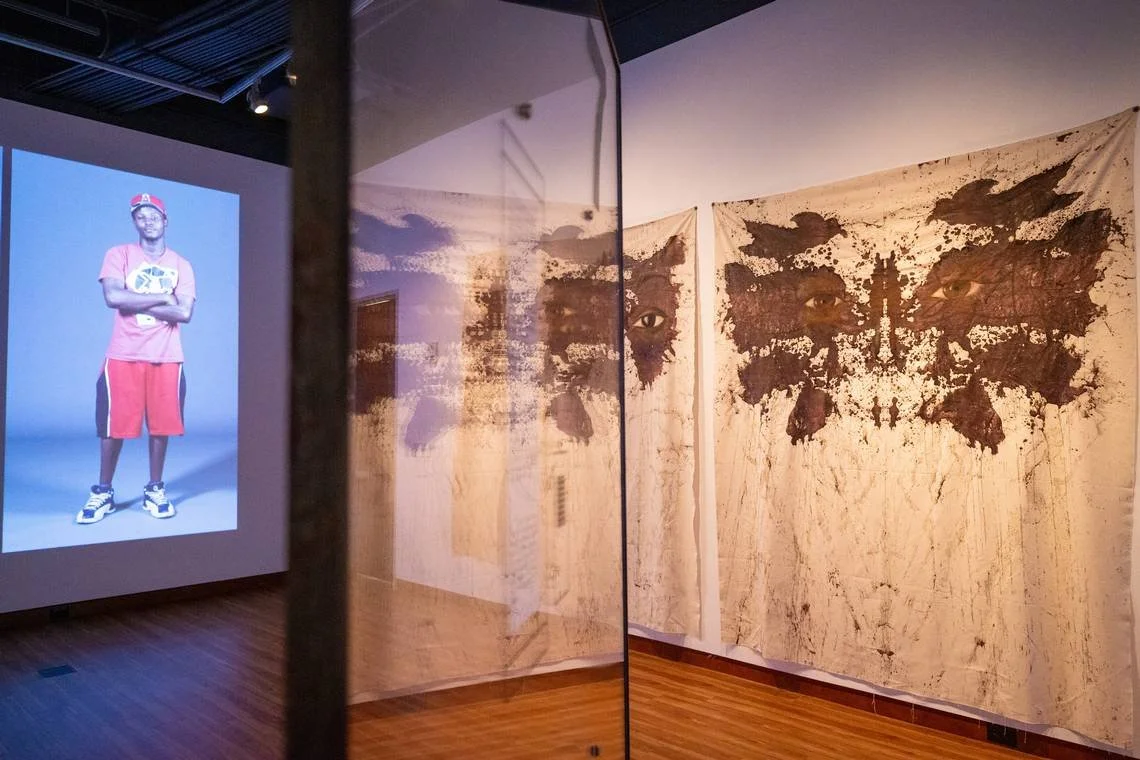Gantt Exhibition Examines Justice System Inequalities

Sherrill Roland spent 10 months and two weeks behind bars for a crime he didn’t commit.
While clocking undeserved time, the Asheville-born artist missed his grandmothers’ funerals and the birth of his daughter. For a time, he spent all but one hour each day secluded in a prison cell with a small, open window.
Feeling exposed, with little privacy, he covered up the cell window with cascading strands of toilet paper that he later wrote messages and musings on.
Some of these are now part of ...and justice for all,” a powerful multimedia exhibition at the Harvey B. Gantt Center for African American Arts + Culture. It remains on exhibit through April 12.

POWERFUL STORIES
“Fig Leaf on Cell #7” is one of the works featured in the exhibition. Handwritten in all caps with black ink, it shares Roland’s thoughts, intended for the mother of his newborn daughter — the musings of a man wrongly convicted. The scroll hangs from a see-through glass door, alone, exposed at the center of the gallery.
The exhibition opened in November as a part of the Gantt’s Initiative for Equity. It seeks to humanize and examine an imperfect criminal justice system.
The Gantt gallery, small and dim, holds powerful stories.
“Yesterday was a tough day mentally for me,” Roland wrote. “I had a little anxiety about the surroundings. Was a little down. … It remains hectic, tension always high.”
Roland was incarcerated in Washington, D.C. after being wrongfully convicted of four misdemeanors.
“Roland was able to use art as a tool to escape, to create, and to express himself,” said Alexys J. Taylor, the Gantt’s exhibitions and collections manager. “We (at the Gantt) use art as a tool to share the stories of hope and community.”

Through large-scale imagery, video and art installations, the Gantt intimately explores the big-picture issues surrounding incarceration — racial profiling, impact on the family and the adverse psychological toll that disproportionately affects communities of color.
“...and justice for all” seeks to humanize and examine a justice system that disproportionately affects people of color.
THE NUMBERS
Visitors to the exhibition learn that the United States has the highest incarceration rate in the world.
In 40 years, America’s prison and jail population has grown 500%. According to the most recent Bureau of Justice Statistics report, the national incarcerated population in 2016 was approximately 2.2 million.
While people of color make up 37% of the U.S. population, they make up 67% of the prison population, according to The Sentencing Project, a nonprofit that works for a fair and effective criminal justice system.
INCREASING AWARENESS
Many of the statistics are projected onto the gallery floor, and while they can incite anger or disbelief, Taylor said the core of the Gantt’s exhibition is not one of national shame, rather of awareness.
“It’s a bit of an emotional roller coaster through here,” she said on a recent tour. “We know that. Our goal is to create dialogue and understanding through the experiences shared in the works.”
Roland’s toilet-paper text, for one, is tender, and, at moments, even funny. “I can’t wait to build forts, tents, and sand castles with her,” he writes of his newborn daughter. “See her reaction when she tastes rainbow sherbet or fried pork chops for the first time. I’ll keep dreaming.”
Then, later, “Today was a better day. Found out I got a job in the kitchen. I’m happy because it takes days off my sentence, pays, and will keep me occupied. They say folks gain weight down there. I’ve always been slim, why not?”
INSIDE THE GALLERY
The soundtrack of the Gantt gallery space comes from controversial Brooklyn-based artist Dread Scott. Larger than life-sized projections of black men, dressed in T-shirts and jeans, are visible on the two shorter ends of the rectangular gallery space.
Through the video installation, Scott addresses the “stop-and-frisk” policing policy. With arms folded or hands in pockets, the frank voices of individual black men say aloud how many times each has been stopped by police in his lifetime: “I’ve been stopped 61 times” one man says. “....About 150 times” and “...Close to 200,” others can be heard saying.
The exhibition makes clear that many things — sentencing policies, implicit racial bias, socioeconomic inequity — all contribute to racial disparities in the criminal justice system.
Hanging on the right side of the room, Russell Craig’s “E. Val” is a series of seven evocative canvases, the faces of men who have been affected by police brutality. The paintings, like inkblots, consist of ox blood stains and acrylic paint.
As part of his psychological evaluations while in the foster care system Craig, a self-taught artist from Philadelphia, was given Rorschach tests. Through his work, which was featured in HBO’s The O.G. Experience, he aimed to represent the psychological trauma felt in black communities.
THE FAMILIES
Photographer-artist Deana Lawson’s work is also featured in the exhibition. It’s a long, vertical series of 42 family portraits that show the unwavering love and devotion that Lawson’s cousin, Jazmin, shared with her boyfriend while he was imprisoned for three years in upstate New York.
Posing with her man and children pridefully in front of a cinder-block mural at the prison — a lighthouse set against a cobalt ocean and smiling sun — Jazmin’s hairstyles change. Cropped cut to long curls. Black hair, then blonde. Her clothing styles evolve, too.
“It shows a different perspective,” said Taylor. “It’s not just about the individual, but about the whole family, and the impact they have while their loved one is behind bars — how they navigate this.”
Original story appears in The Charlotte Observer.

